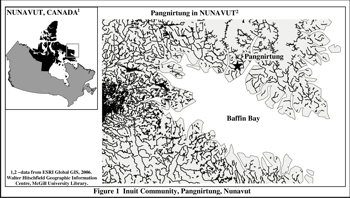INUIT, BAFFIN REGION, NUNAVUT TERRITORY, CANADA
Community Food System Data Tables
Introduction

The Territory of Nunavut was formed in 1992, and represents an Inuit self-ruled territory. The Baffin Region of Nunavut is the most traditional of Canadian Inuit Regions and is home to Inuit (Figure 1).
Studies in this region have shown that traditional food has a central role in the life of Inuit. Therefore, with support from the Northern Contaminants Program and with participation and guidance of the Inuit Tapiriit of Canada, the research took place from 1997 -2000 in 5 regions of Inuit communities with the objectives:
- To derive quantitative estimates of traditional/country and market food intake among Inuit in 5 regions (Inuvialuit, Kitikmeot, Keewatin, Baffin and Labrador), representing approximately 50 communities.
- To complete databases of nutrient and contaminant contents of traditional foods.
- To define benefits of traditional foods in terms of nutritional, socioeconomic and cultural significance.
- To define the levels of dietary exposure to contaminants (mercury, cadmium, arsenic, lead and several organochlorines).
A total of 1929 participants were randomly selected for interviews. The information on food consumption took place during fall of 1998 and winter of 1999, using 24- hr recalls, food frequency interviews, and 7-day food records.
The study team for the project in Pangnirtung for the Global Health work of CINE was comprised of the following:
Centre for Indigenous Peoples’ Nutrition and Environment (CINE), McGill University, Québec, Canada, H9X 3V9.
- Grace M. Egeland, Ph.D.
- Rula Souieda
- Harriet Kuhnlein, Ph.D., R.D
Inuit Tapiriit Kanatami, Health Office, Ottawa, Ontario, Canada
- Looee Okalik
- Eric Loring
Notes on food groups
Seventy-nine different foods were identified for use in Baffin region, where Pangnirtung is located and among these are numerous species of fish and shellfish, marine and land mammals, birds, plant and berries as part of the traditional food system. The analyses of all foods were carried out in the CINE laboratory.
Information on 79 foods collected was divided into five groups:
- Fish and Seafood
- Sea Mammals
- Land Mammals
- Game and Birds
- Berries
Nutrient composition of Baffin Inuit foods is presented in CINE's Arctic Nutrient File providing access to nutrient information on traditional food (country food) for Canada’s Northern Indigenous Peoples.
The purpose of this resource is to present a reflection of the usual composition of foods available and/or consumed among Inuit community members. This is a living document and nutrient information will be added and/or updated when available.
Seasonality of use, harvest information, type of procurement and other relevant information were collected through household and key informant interviews.
Notes on food components
Vitamin A values are reported in both Vitamin A retinol equivalents (RE-µg) and in retinol activity equivalents (RAE-µg). These values are calculated and reported for only those foods for which retinol, beta carotene and total carotene values are available. Vitamin A (RAE-µg) values are reported for compatibility with the DRI (Dietary Reference Intake) recommendations.
Folate values are reported in Dietary Folate Equivalent (DFE), in addition to reporting of natural folate present in foods
References
- Fediuk, K., Hidiroglou, N., Madère, R. & Kuhnlein, H.V. (2002) Vitamin C in Inuit traditional food and women’s diets. J. Food Compos. Anal. 15: 221-235.
- Kuhnlein, H.V., Receveur, O., Chan H.M., and Loring E. (2000) Assessment of Dietary Benefit/Risk in Inuit Communities. Technical report (ISBN # 0-7717-0558-1). Centre for Indigenous Peoples’ Nutrition and Environment (CINE), McGill. With thanks to Dr. Hope Weiler for making the pdf of this resource available:
 assessment_of_dietary_benefit_risk_in_inuit_communities.pdf
assessment_of_dietary_benefit_risk_in_inuit_communities.pdf - Kuhnlein, H. V., Kubow, S. & Soueida, R. (1991) Lipid components of traditional Inuit foods and diets of Baffin Island. J. Food Compos. Anal. 4(3): 227-236.
- Kuhnlein, H. V. & Soueida, R. (1992) Use and nutrient composition of traditional Baffin Inuit foods. J. Food Compos. Anal. 5(2): 112-126.
- Kuhnlein, H. V., Receveur, O. & Ing, A. (2001) Energy, fat and calcium in bannock consumed by Canadian Inuit. J. Am. Diet. Assoc. 101(5): 580-581.
- Kuhnlein, H. V., Chan, H. M., Leggee, D. & Barthet, V. (2002) Macronutrient, mineral and fatty acid composition of Canadian Arctic traditional food. J. Food Compos. Anal. 15: 545-566.
- Kuhnlein, H. V., Barthet, V., Farren, E., Falahi, E., Leggee, D., Receveur, O. and Berti, P. (2006) Vitamins A, D, and E in Canadian Arctic Traditional Food and Adult Diets. J. Food Compos. Anal. 19: 495-506.